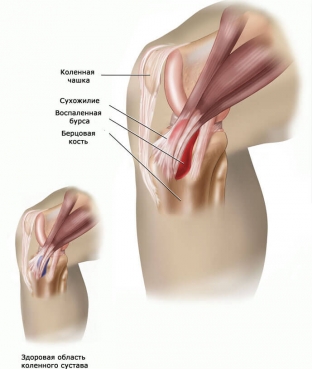While walking, sitting or standing, a huge load is placed on the joints. To prevent distortion of all parts of the joint necessary for flexion and sliding, a secret is secreted - synovial fluid. It is produced by the cells of the inner surface of the bursa - the articular bag, which can become inflamed from time to time. Swelling above the knee, pain, fever, muscle weakness are signs of an inflammatory process in the joint bag. This disease is called knee bursitis. Estet-portal.com will tell you about the symptoms and causes of knee bursitis, about the methods of treating this disease.
Features of bursitis, varieties
Joints are responsible for the smoothness and clarity of movements: elbow, knee, hip, shoulder, heel. Each contains joint bags with synovial fluid. If the bursa or bursa becomes inflamed, bursitis begins.
Inflammation of the joint capsule can be accompanied by a rich clinical picture: pain, redness, suppuration, swelling - with all the ensuing consequences: loss of motor ability of the joint, destruction of the joint itself.
Bursitis types by location:
- elbow;
- shoulder;
- femoral;
- knee;
- calcaneal;
- ankle;
- wrist;
- thumb.
Read also: Bursitis of the thumb - causes, treatment and prevention
Varieties of bursitis by causes:
- septic (infectious);
- aseptic.
Bursitis develops after an infection with blood enters the bag or through trauma.
What is knee bursitis
Knee bursitis is an inflammation of one of the knee bursae. The knee joint is considered the most fragile due to the constant load on it. Types of knee bursitis:
- suprapatellar or patella - the patella bursa of the joint becomes inflamed. It can develop after an injury to the leg, in particular the knee, or in the case of constant kneeling - a deformation of the joint occurs, which causes an inflammatory process;
- infrapatellar or popliteal - when the synovial sac under the knee becomes inflamed. May begin due to damage to the popliteal ligaments;
- Baker's cyst is an inflammation of the joint capsule in the lower inner part of the knee. This type of disease appears in people who are overweight due to a large load on the joints and constant microtraumatization of the tendons.

Causes and symptoms of the development of the disease
Bruises, abrasions, significant and minor injuries of the knee are imprinted on the state of joint performance, which in the future may provoke the development of bursitis of the knee joint. The disease can develop after a sprain or damage to the skin near the knee. Also, the development of the disease is affected by allergic reactions, infectious diseases, autoimmune processes, metabolic disorders.
Find out Why knees hurt: causes and effects
The main causes of knee bursitis are:
- overweight;
- constant physical activity;
- knee injury;
- skin lesions in the knee area;
- presence of concomitant diseases: gout, psoriasis, rheumatitis.
The main symptoms of knee bursitis:
- swelling of the affected articular sac and respectively of the knee;
- redness;
- pain when walking, at rest, pain on palpation;
- muscle weakness;
- temperature increase in the area of inflammation of the articular bag;
- an increase in body temperature in the acute course of the disease.
Important! Bursitis of the knee joint differs from arthritis of the same joint by local pain and swelling in the area of the inflamed periarticular sac. With arthritis, the knee can become completely inflamed, there are no specific boundaries, as with bursitis.
Generally accepted treatments for this type of bursitis
It is not recommended to resort to self-treatment of this disease. Only a traumatologist or surgeon can make a diagnosis and prescribe the necessary therapy. To achieve success in the treatment of knee bursitis, it is better to immobilize the leg completely or partially. Keep your knee elevated. In the case of aseptic bursitis, you can apply a compress to the knee - cold or even ice cold. With a strong pain syndrome, the doctor may prescribe non-steroidal anti-inflammatory drugs, painkillers. In addition, physiotherapy procedures (electrophoresis, magnet, paraffin), massage, as well as physiotherapy exercises can be used after the elimination of acute symptoms and pain in the process of rehabilitation therapy. Antibiotic therapy is prescribed at the initial stage of the acute course of bursitis, with an infectious form, with injury or traumatic bursitis. If a sufficient amount of pus has accumulated in the bag, it is necessary to perform a puncture - a puncture of the periarticular bag in order to extract the exudate. An antibiotic and an anti-inflammatory agent may be injected into the cavity. If a Baker's cyst develops, surgical removal of the cyst is indicated.






Add a comment